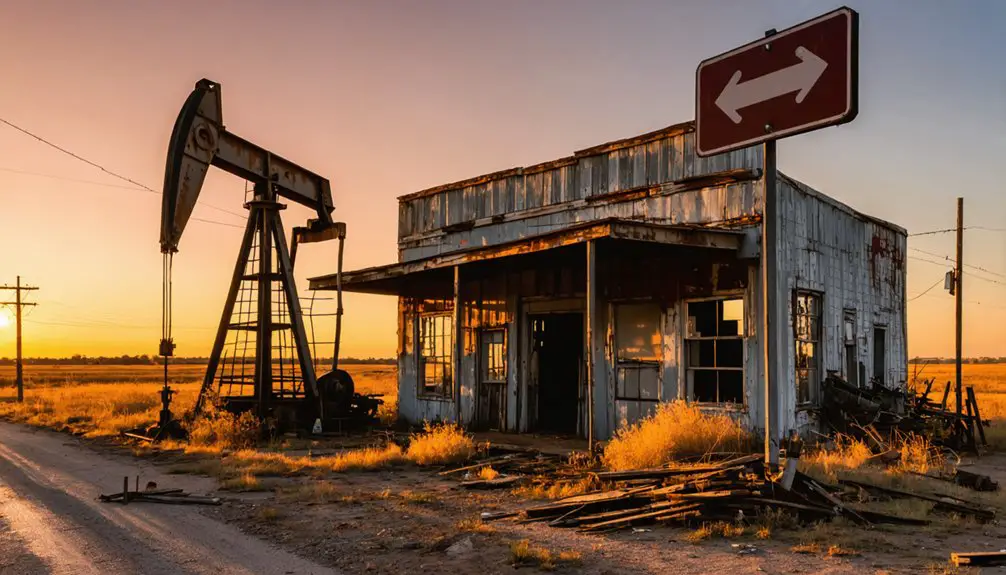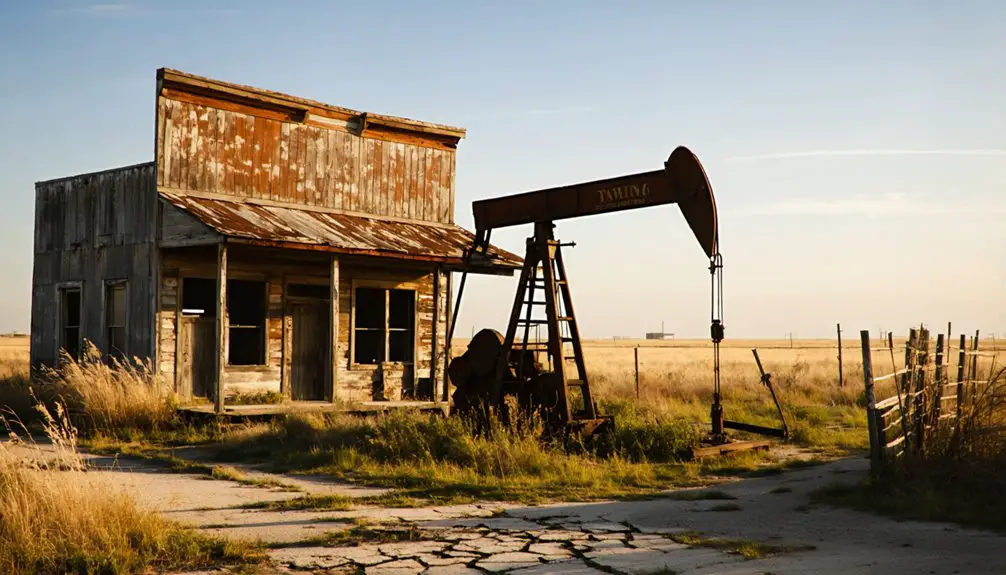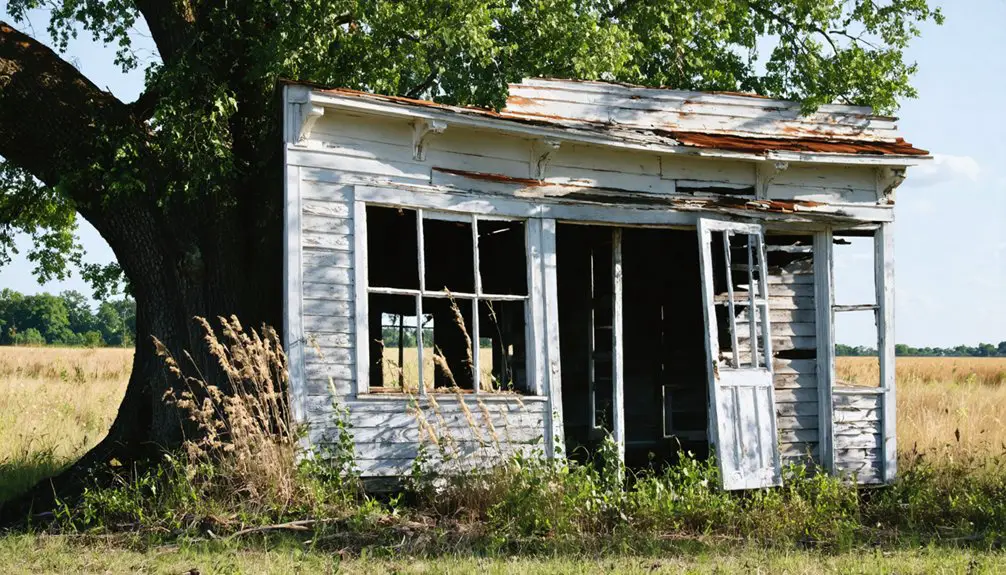If you’re seeking remnants of Oklahoma’s lumber heritage, you’ll find Kinzua’s ghostly traces scattered across the landscape. This former company town, built around the Kinzua Pine Mills Company, reached its peak in 1950 with 700 residents enjoying modern amenities, a thriving Main Street, and the iconic Jinks Hotel. Today, nature reclaims the abandoned structures where a close-knit community once prospered, each weathered building holding stories of Oklahoma’s resource-driven past.
Key Takeaways
- Kinzua was established in 1928 around the Kinzua Pine Mills Company, reaching its peak with 700 residents and modern amenities.
- The town thrived on lumber industry operations, featuring company-built homes, stores, and social venues including a golf course.
- Economic decline began when resources depleted, causing massive population loss and business closures by mid-20th century.
- Today, Kinzua stands abandoned with deteriorating structures, empty homes, and foundations being reclaimed by nature.
- The ghost town serves as a testament to Oklahoma’s resource-dependent boom-and-bust economic cycles.
The Rise of a Railroad Boomtown
When E.D. Wetmore envisioned a thriving lumber empire in 1928, he knew railroad construction would be essential to his ambitious plans.
You can trace his strategic thinking in how he acquired 50,000 acres of pristine timberland across Oregon, Washington, and Arizona, naming his new venture after Pennsylvania’s Kinzua River.
Just like the Eighth Wonder World, the town’s development marked a significant milestone in railroad history.
The timber industry quickly transformed this wilderness into a bustling company town built around the Kinzua Pine Mills Company.
You’d have found yourself among 700 residents at its peak, with access to modern amenities rarely seen in remote logging communities.
The railroad became the town’s lifeline, connecting workers to 125 homes, stores, and social venues.
More than just tracks and timber, this was a carefully planned community where the freedom of the frontier met industrial progress.
The town’s amenities included a unique attraction with a lake full of trout that drew visitors from far and wide.
Daily Life in Early Kinzua
Life in early Kinzua offered a distinct blend of industrial practicality and thoughtful community planning. You’d find yourself living in one of 125 company-built homes, working at the Kinzua Pine Mills Company alongside your neighbors. Your daily routine would revolve around the mill’s schedule, but you’d enjoy diverse amenities rare for a remote town of that era. Like the land rush settlers of 1889, residents here were drawn by the promise of new opportunities. Water was plentiful and easily accessible, unlike the dollar per bucket prices faced by early Oklahoma settlers.
The town’s social hubs buzzed with activity – you could unwind at the tavern after work, fish in the trout-filled lake, or perfect your swing at the golf course. Community events brought everyone together, while the library provided intellectual stimulation.
You’d shop at local grocery and department stores, get your hair cut at the barber, and find medical care at the first-aid station. The railroad kept you connected to the wider world through Condon.
Economic Peak and Notable Landmarks
You’d have witnessed Kinzua’s economic zenith around 1950 when the railroad’s steady flow of timber and supplies helped sustain a population of 700 residents.
The town’s prosperity radiated from its industrial core at the Kinzua Pine Mills Company, where massive logging operations processed the region’s abundant Ponderosa Pine. Similar to Japan’s postwar economic boom, the region experienced significant development and growth during this period.
Main Street reflected this wealth through its commercial hub of grocery stores, department stores, and social establishments that served both workers and visitors alike. Notable businesses like Jinks Hotel stood as landmarks of the town’s thriving commerce.
Railroad Prosperity Era
During the late 19th century, Kinzua’s prosperity reached its zenith with the completion of the legendary Kinzua Bridge in 1882, a marvel that held the title of world’s tallest railroad bridge for two years.
The rapid railroad expansion transformed the region’s economic landscape, enabling widespread resource extraction and market access that would shape the area’s destiny. The original construction was completed by a crew of 40 in just 94 working days without using any scaffolding. The bridge remained an engineering marvel for over a century until its destruction by a tornado in 2003.
- You’ll find evidence of booming coal and timber operations that thrived along multiple spur lines.
- The bridge’s 1900 rebuild accommodated heavier trains, including Erie Railroad’s mighty 2-8-2 Mikado locomotives.
- Foreign investors from Britain, Germany, and the Netherlands fueled the railway’s growth.
- Small settlements like Bachus, Kushequa, and Westline flourished along the route.
- A 5 mph speed limit for steam locomotives reflected the careful balance between commerce and infrastructure preservation.
Mining Operations History
As the coal industry began to take root in 1872, Kinzua’s mining operations flourished across a vast 16-county expanse of eastern Oklahoma.
You’d have witnessed the evolution of mining techniques, from traditional underground methods to more efficient surface extraction by mid-century. The region’s superior coal quality, first championed by James J. McAlester, attracted major railroad investments, including the iconic Kinzua Bridge.
Production soared from modest beginnings of 100,000 tons to an impressive 3.5 million tons by 1903, valued over $6 million. The Missouri Kansas and Texas railway played a crucial role in transporting coal and expanding market access. The area saw vibrant social activities emerge, including opera houses and community bands.
The bustling company towns near crucial rail junctions became economic powerhouses, though they often controlled workers through scrip payments.
While this era brought unprecedented prosperity, it also transformed the landscape, leaving behind a legacy of abandoned mines and altered terrain that you can still explore today.
Main Street Business District
The bustling Main Street of Kinzua reached its zenith in the early 20th century, when a vibrant mix of general stores, saloons, and specialty shops lined the town’s primary thoroughfare.
You’d find an impressive business variety catering to miners and their families, with community services centered around the prominent post office and railroad depot.
- General stores stocked essentials from work boots to mining tools
- Saloons and taverns provided entertainment after long shifts
- Boarding houses welcomed temporary workers and travelers
- Confectioneries and bakeries added sweetness to daily life
- Blacksmiths and repair shops kept the town’s equipment running
The district thrived through the 1930s, with wooden boardwalks connecting establishments while street lamps illuminated the path for evening shoppers.
Behind Main Street, the railroad tracks facilitated a steady flow of goods and resources.
The Turning Point and Decline

Once prosperous and bustling with activity, Kinzua’s fate turned dramatically when its oil wells began drying up in the mid-20th century. The resource depletion triggered a devastating chain reaction – jobs vanished, businesses shuttered, and families packed up their lives in search of new opportunities.
You’d have witnessed the town’s liveliness drain away as the younger generation fled to urban centers, leaving behind an aging population struggling to maintain their community’s identity.
The town’s isolation deepened as transportation routes bypassed it entirely. With no railroad or highway access, you couldn’t sustain trade or attract new business.
Demographic shifts hit hard – schools merged, churches closed, and the social fabric unraveled. By the time the dust settled, Kinzua had lost over 80% of its population, becoming another example of Oklahoma’s boom-and-bust legacy.
What Remains Today
Today, scattered remnants of Kinzua’s past dot the weathered Oklahoma landscape, telling silent stories of a community that time forgot.
Like ghostly footprints in history’s dust, Kinzua’s abandoned remains whisper tales of Oklahoma’s forgotten places.
You’ll find abandoned structures in various states of decay, from weathered homes with broken windows to rusted service station signs that haven’t seen customers in years. The environmental conditions have taken their toll, with nature slowly reclaiming what humans left behind.
- Empty homes stand as silent sentinels, their windows dark and walls weathered
- Foundations of former businesses peek through overgrown vegetation
- Old motel ruins remind visitors of busier days gone by
- Rusty signage clings to decaying buildings, fading with each passing season
- Vacant lots where buildings once stood now merge with the wild landscape
Unlike nearby Picher’s toxic legacy, Kinzua’s abandonment stems purely from time’s passage, leaving a hauntingly beautiful reminder of Oklahoma’s past.
Historical Significance and Legacy

Legacy runs deep in Kinzua’s weathered bones, where a once-thriving lumber company town exemplified Oklahoma’s early industrial ambitions.
As you explore its history, you’ll find a microcosm of the state’s resource-driven boom-and-bust cycle, where timber fueled both dreams and eventual decline.
The cultural impact of Kinzua extends beyond its physical remains, preserved in the community narratives of former residents who recall a close-knit society built around the rhythms of mill work.
You’ll discover how the company-sponsored churches, stores, and schools created a distinctive social fabric that defined life in this planned community.
Today, Kinzua’s story serves as a powerful reminder of Oklahoma’s industrial heritage and the temporary nature of prosperity tied to natural resource exploitation.
Frequently Asked Questions
Were Any Paranormal Activities Ever Reported in Kinzua?
You won’t find documented ghost sightings or paranormal investigations in the historical records of this location. While it’s a ghost town, there aren’t any widely reported supernatural occurrences tied to its mining past.
What Happened to the Cemetery After the Town Was Abandoned?
You’ll find the cemetery’s fate remains uncertain, with likely deterioration and limited preservation efforts. Local stories hint at ghostly encounters, but physical evidence of graves has faded into Oklahoma’s untamed landscape.
Did Any Famous Outlaws Ever Visit or Hide in Kinzua?
You won’t find any confirmed outlaw sightings or historical legends about famous outlaws visiting Kinzua. Research shows it was primarily a timber town without documented connections to notorious criminals.
What Was the Average Property Value in Kinzua During Its Peak?
You won’t find exact average property values recorded due to Kinzua’s nature as a company town. Most housing was company-owned, with values tied to mill operations before economic decline led to abandonment.
Did Native American Tribes Have Any Settlements in the Area Before Kinzua?
Yes, you’ll find that Kiowa and Plains Apache tribes established native settlements in the area before Kinzua. They’d created extensive hunting territories and tribal lands throughout southwestern Oklahoma during the 18th century.
References
- https://en.wikipedia.org/wiki/List_of_ghost_towns_in_Oklahoma
- https://www.youtube.com/watch?v=5d-wHDTIbb0
- https://www.okhistory.org/publications/enc/entry?entry=GH002
- https://www.kosu.org/local-news/2014-05-23/ghost-towns-all-black-oklahoma-towns
- https://kids.kiddle.co/List_of_ghost_towns_in_Oklahoma
- https://lumberheritage.org/heritage/knox-and-kane-railroad/
- https://www.oregonencyclopedia.org/articles/kinzua/
- https://en.wikipedia.org/wiki/Kinzua_Bridge
- http://www.kinzuavalleytrail.org/industrialization
- https://www.pa.gov/agencies/dcnr/recreation/where-to-go/state-parks/find-a-park/kinzua-bridge-state-park/history.html



